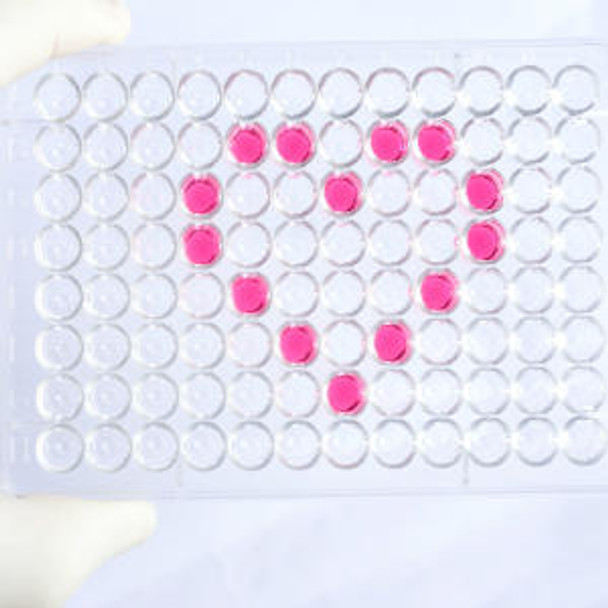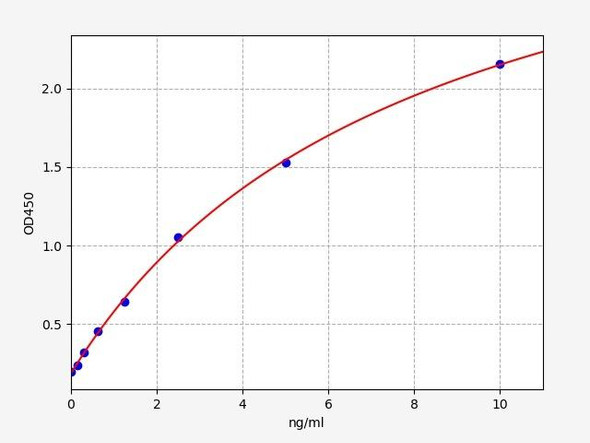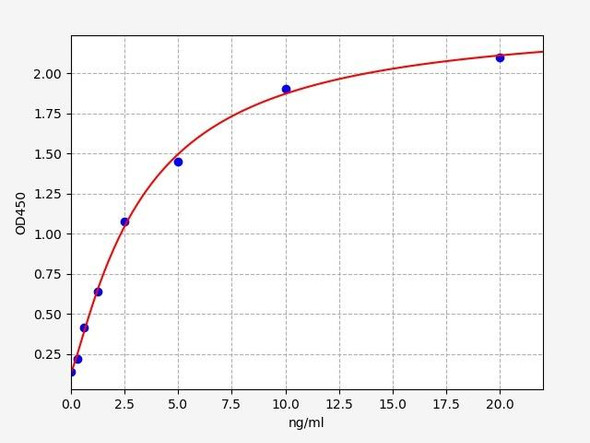Human Axin-2 (AXIN2) ELISA Kit (HUEB2671)
- SKU:
- HUEB2671
- Product Type:
- ELISA Kit
- Size:
- 96 Assays
- Uniprot:
- Q9Y2T1
- Range:
- 0.312-20 ng/mL
- ELISA Type:
- Sandwich
- Synonyms:
- AXIN2, Axis Inhibitor 2, AXIL, Conductin, MGC10366, MGC126582, Axil, axin 2, axin-2, Axin-like protein, Axis inhibition protein 2, conductin
- Reactivity:
- Human
Description
Human Axin-2 (AXIN2) ELISA Kit
The Human Axin-2 (Axin2) ELISA Kit is specifically designed for the precise quantification of Axin-2 levels in human serum, plasma, and cell culture supernatants. This kit offers exceptional sensitivity and specificity, ensuring accurate and consistent results for various research applications.Axin-2 is a key regulatory protein in the Wnt signaling pathway, playing a critical role in controlling cell proliferation, differentiation, and tissue homeostasis. Dysregulation of the Wnt pathway and Axin-2 expression has been implicated in various diseases, including cancer, Alzheimer's disease, and osteoporosis, highlighting the significance of Axin-2 as a potential biomarker and therapeutic target.
By utilizing the Human Axin-2 ELISA Kit, researchers can gain valuable insights into the role of Axin-2 in disease pathogenesis and progression, ultimately paving the way for the development of novel diagnostic tools and therapeutic interventions.
| Product Name: | Human Axin-2 (AXIN2) ELISA Kit |
| SKU: | HUEB2671 |
| Size: | 96T |
| Target: | Human Axin-2 (AXIN2) |
| Synonyms: | Axin-like protein, Axis inhibition protein 2, Conductin, Axil |
| Assay Type: | Sandwich |
| Detection Method: | ELISA |
| Reactivity: | Human |
| Detection Range: | 0.312-20ng/mL |
| Sensitivity: | 0.1ng/mL |
| Intra CV: | 5.1% | ||||||||||||||||||||
| Inter CV: | 9.6% | ||||||||||||||||||||
| Linearity: |
| ||||||||||||||||||||
| Recovery: |
| ||||||||||||||||||||
| Function: | Inhibitor of the Wnt signaling pathway. Down-regulates beta-catenin. Probably facilitate the phosphorylation of beta-catenin and APC by GSK3B. |
| Uniprot: | Q9Y2T1 |
| Sample Type: | Serum, plasma, tissue homogenates, cell culture supernates and other biological fluids |
| Specificity: | Natural and recombinant human Axin-2 |
| Sub Unit: | Interacts with glycogen synthase kinase-3 beta (GSK3B) and beta-catenin. The interaction between axin and beta-catenin occurs via the armadillo repeats contained in beta-catenin (By similarity). Interacts with SMAD7 and RNF111. Interacts with ANKRD6. |
| Research Area: | Cancer |
| Subcellular Location: | Cytoplasm |
| Storage: | Please see kit components below for exact storage details |
| Note: | For research use only |
| UniProt Protein Function: | axin 2: is a negative regulator of the Wnt pathway, which is critical in stem cell signaling, morphogenesis, the mesenchymal-epithelial transition, and many cancers. Axin functions as a tumor suppressor. Probably facilitates the phosphorylation of beta-catenin and APC by GSK3B, leading to their ubiquitination and subsequent proteolysis. Is downregulated during progression of esophageal squamous cell carcinoma. Axin1/2 mediate cross-talk between TGF-beta and Wnt signaling pathways. |
| UniProt Protein Details: | Protein type:Adaptor/scaffold Chromosomal Location of Human Ortholog: 17q24.1 Cellular Component: nucleoplasm; microtubule cytoskeleton; Golgi apparatus; centrosome; cytoplasmic microtubule; cytoplasm; cytoplasmic membrane-bound vesicle; postsynaptic density; plasma membrane; cell cortex; cytosol; nucleus; beta-catenin destruction complex Molecular Function:protein binding; enzyme binding; ubiquitin protein ligase binding; beta-catenin binding; protein kinase binding; GTPase activator activity Biological Process: odontogenesis; negative regulation of cell proliferation; cell proliferation; intramembranous ossification; regulation of mismatch repair; mRNA stabilization; dorsal/ventral axis specification; negative regulation of osteoblast differentiation; positive regulation of protein amino acid phosphorylation; maintenance of DNA repeat elements; bone mineralization; positive regulation of GTPase activity Disease: Oligodontia-colorectal Cancer Syndrome |
| NCBI Summary: | The Axin-related protein, Axin2, presumably plays an important role in the regulation of the stability of beta-catenin in the Wnt signaling pathway, like its rodent homologs, mouse conductin/rat axil. In mouse, conductin organizes a multiprotein complex of APC (adenomatous polyposis of the colon), beta-catenin, glycogen synthase kinase 3-beta, and conductin, which leads to the degradation of beta-catenin. Apparently, the deregulation of beta-catenin is an important event in the genesis of a number of malignancies. The AXIN2 gene has been mapped to 17q23-q24, a region that shows frequent loss of heterozygosity in breast cancer, neuroblastoma, and other tumors. Mutations in this gene have been associated with colorectal cancer with defective mismatch repair. [provided by RefSeq, Jul 2008] |
| UniProt Code: | Q9Y2T1 |
| NCBI GenInfo Identifier: | 12643949 |
| NCBI Gene ID: | 8313 |
| NCBI Accession: | Q9Y2T1.1 |
| UniProt Secondary Accession: | Q9Y2T1,Q3MJ88, Q9H3M6, Q9UH84, |
| UniProt Related Accession: | Q9Y2T1 |
| Molecular Weight: | 843 |
| NCBI Full Name: | Axin-2 |
| NCBI Synonym Full Names: | axin 2 |
| NCBI Official Symbol: | AXIN2 |
| NCBI Official Synonym Symbols: | AXIL; ODCRCS |
| NCBI Protein Information: | axin-2; conductin; axin-like protein; axis inhibition protein 2 |
| UniProt Protein Name: | Axin-2 |
| UniProt Synonym Protein Names: | Axin-like protein; Axil; Axis inhibition protein 2; Conductin |
| Protein Family: | Axin |
| UniProt Gene Name: | AXIN2 |
| UniProt Entry Name: | AXIN2_HUMAN |
| Component | Quantity (96 Assays) | Storage |
| ELISA Microplate (Dismountable) | 8×12 strips | -20°C |
| Lyophilized Standard | 2 | -20°C |
| Sample Diluent | 20ml | -20°C |
| Assay Diluent A | 10mL | -20°C |
| Assay Diluent B | 10mL | -20°C |
| Detection Reagent A | 120µL | -20°C |
| Detection Reagent B | 120µL | -20°C |
| Wash Buffer | 30mL | 4°C |
| Substrate | 10mL | 4°C |
| Stop Solution | 10mL | 4°C |
| Plate Sealer | 5 | - |
Other materials and equipment required:
- Microplate reader with 450 nm wavelength filter
- Multichannel Pipette, Pipette, microcentrifuge tubes and disposable pipette tips
- Incubator
- Deionized or distilled water
- Absorbent paper
- Buffer resevoir
*Note: The below protocol is a sample protocol. Protocols are specific to each batch/lot. For the correct instructions please follow the protocol included in your kit.
Allow all reagents to reach room temperature (Please do not dissolve the reagents at 37°C directly). All the reagents should be mixed thoroughly by gently swirling before pipetting. Avoid foaming. Keep appropriate numbers of strips for 1 experiment and remove extra strips from microtiter plate. Removed strips should be resealed and stored at -20°C until the kits expiry date. Prepare all reagents, working standards and samples as directed in the previous sections. Please predict the concentration before assaying. If values for these are not within the range of the standard curve, users must determine the optimal sample dilutions for their experiments. We recommend running all samples in duplicate.
| Step | |
| 1. | Add Sample: Add 100µL of Standard, Blank, or Sample per well. The blank well is added with Sample diluent. Solutions are added to the bottom of micro ELISA plate well, avoid inside wall touching and foaming as possible. Mix it gently. Cover the plate with sealer we provided. Incubate for 120 minutes at 37°C. |
| 2. | Remove the liquid from each well, don't wash. Add 100µL of Detection Reagent A working solution to each well. Cover with the Plate sealer. Gently tap the plate to ensure thorough mixing. Incubate for 1 hour at 37°C. Note: if Detection Reagent A appears cloudy warm to room temperature until solution is uniform. |
| 3. | Aspirate each well and wash, repeating the process three times. Wash by filling each well with Wash Buffer (approximately 400µL) (a squirt bottle, multi-channel pipette,manifold dispenser or automated washer are needed). Complete removal of liquid at each step is essential. After the last wash, completely remove remaining Wash Buffer by aspirating or decanting. Invert the plate and pat it against thick clean absorbent paper. |
| 4. | Add 100µL of Detection Reagent B working solution to each well. Cover with the Plate sealer. Incubate for 60 minutes at 37°C. |
| 5. | Repeat the wash process for five times as conducted in step 3. |
| 6. | Add 90µL of Substrate Solution to each well. Cover with a new Plate sealer and incubate for 10-20 minutes at 37°C. Protect the plate from light. The reaction time can be shortened or extended according to the actual color change, but this should not exceed more than 30 minutes. When apparent gradient appears in standard wells, user should terminatethe reaction. |
| 7. | Add 50µL of Stop Solution to each well. If color change does not appear uniform, gently tap the plate to ensure thorough mixing. |
| 8. | Determine the optical density (OD value) of each well at once, using a micro-plate reader set to 450 nm. User should open the micro-plate reader in advance, preheat the instrument, and set the testing parameters. |
| 9. | After experiment, store all reagents according to the specified storage temperature respectively until their expiry. |
When carrying out an ELISA assay it is important to prepare your samples in order to achieve the best possible results. Below we have a list of procedures for the preparation of samples for different sample types.
| Sample Type | Protocol |
| Serum | If using serum separator tubes, allow samples to clot for 30 minutes at room temperature. Centrifuge for 10 minutes at 1,000x g. Collect the serum fraction and assay promptly or aliquot and store the samples at -80°C. Avoid multiple freeze-thaw cycles. If serum separator tubes are not being used, allow samples to clot overnight at 2-8°C. Centrifuge for 10 minutes at 1,000x g. Remove serum and assay promptly or aliquot and store the samples at -80°C. Avoid multiple freeze-thaw cycles. |
| Plasma | Collect plasma using EDTA or heparin as an anticoagulant. Centrifuge samples at 4°C for 15 mins at 1000 × g within 30 mins of collection. Collect the plasma fraction and assay promptly or aliquot and store the samples at -80°C. Avoid multiple freeze-thaw cycles. Note: Over haemolysed samples are not suitable for use with this kit. |
| Urine & Cerebrospinal Fluid | Collect the urine (mid-stream) in a sterile container, centrifuge for 20 mins at 2000-3000 rpm. Remove supernatant and assay immediately. If any precipitation is detected, repeat the centrifugation step. A similar protocol can be used for cerebrospinal fluid. |
| Cell culture supernatant | Collect the cell culture media by pipette, followed by centrifugation at 4°C for 20 mins at 1500 rpm. Collect the clear supernatant and assay immediately. |
| Cell lysates | Solubilize cells in lysis buffer and allow to sit on ice for 30 minutes. Centrifuge tubes at 14,000 x g for 5 minutes to remove insoluble material. Aliquot the supernatant into a new tube and discard the remaining whole cell extract. Quantify total protein concentration using a total protein assay. Assay immediately or aliquot and store at ≤ -20 °C. |
| Tissue homogenates | The preparation of tissue homogenates will vary depending upon tissue type. Rinse tissue with 1X PBS to remove excess blood & homogenize in 20ml of 1X PBS (including protease inhibitors) and store overnight at ≤ -20°C. Two freeze-thaw cycles are required to break the cell membranes. To further disrupt the cell membranes you can sonicate the samples. Centrifuge homogenates for 5 mins at 5000xg. Remove the supernatant and assay immediately or aliquot and store at -20°C or -80°C. |
| Tissue lysates | Rinse tissue with PBS, cut into 1-2 mm pieces, and homogenize with a tissue homogenizer in PBS. Add an equal volume of RIPA buffer containing protease inhibitors and lyse tissues at room temperature for 30 minutes with gentle agitation. Centrifuge to remove debris. Quantify total protein concentration using a total protein assay. Assay immediately or aliquot and store at ≤ -20 °C. |
| Breast Milk | Collect milk samples and centrifuge at 10,000 x g for 60 min at 4°C. Aliquot the supernatant and assay. For long term use, store samples at -80°C. Minimize freeze/thaw cycles. |








